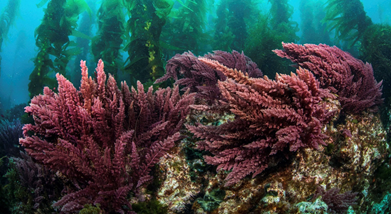THE INNOVATION EXPLAINED
Introduction
Enteric emissions are a huge problem in livestock farming. Feed is converted in the rumen to volatile fatty acids, CO2 and H. Volatile fatty acids are building blocks for further digestion, while CO2 and H are converted to CH4 by methanogenic microorganisms. The formation of CH4 is a natural process related to the fermentation of feedstuff. However, as it contributes to global warming, it is an unwanted by-product of rumen fermentation. Many solutions exist to decrease the formation of CH4 and most promising strategies are related to feed management. Lately more research has been done on the use of seaweed. In vitro, some seaweed have shown great potential to reduce CH4 emissions. However, the better the seaweed is, the more bromoform it contains. Bromoform is an organic solvent which is known for its toxicity. When added to the diet of cattle, it can mitigate to milk and meat, which is unwanted.
Seaweed in general
Looking at feed sources coming from aquatic biomass could be interesting as 70% of the globe is covered with water. In addition, using this food source may reduce the land use necessary for feed production. As explained in the introduction, many types have shown great potential in vitro, however also many different types of seaweed did not seem promising.
More than 10.000 species of seaweed exist, which can be divided in brown, red and green types. They do not contain lignin, but have various other types of carbohydrate structures. Depending on the use in the diet, seaweed can deliver energy and nutrients (added as a feed material). However, the chemical composition is important, as well as the effects on intake, rumen fermentation and performance. This can compete with terrestrial feeds for costs, volume, safety and health. Adding seaweed as a feed additive is done for its specific bio-functionality.
Red seaweed Asparagopsis taxiformis
The University of California, Davis, investigated the effect of Asparagopsis taxiformis, which is a red seaweed and has great methane reducing potential (50-99%) in both in vitro and in vivo trials (Roque et al. 2021). However, it is a brominated and chlorinated halomethane. These substances are part of the chemical defence mechanism of the algae, but are also ozone-depleting and carcinogenic. Some studies showed residues of bromoform in meat and milk, and as this bromoform is toxic, the question exist if this is an interesting seaweed to add in cattle diet.
Roque et al. (2021) and Kinley et al. (2019) performed several trials in steers and did not find any bromoform residues in meat, organs and faeces. As not all studies have the same results, the question remains if adding A. taxiformis is interesting and research is ongoing to find other species of algae for CH4 reduction with low to no bromoform.
In addition, the trial was performed in steers in a feedlot, where CH4 emissions are already much lower (11% of their total CH4 emissions) compared to emissions from more extensive systems (grazing, 80% CH4 emissions). With this in mind, it is possible that the impact of seaweed has been heavily overestimated. In vivo trials should be performed in different production systems, like grazing systems.
 |  |
Pictures A. taxiformis (Greener Grazing™️)
Working mechanisms of A. taxiformis
The active component in the red seaweed A. taxiformis able to reduce enteric CH4 emissions is bromoform. It inhibits enzyme activity needed for CH4 production by methanogenic rumen microbes. They bind and sequester the prosthetic group required by methyl-coenzym M reductase (catalyst final step) in order to form CH4. This way, they inhibit the reaction that is necessary in the CH4 biosynthesis.
Other algae
Other groups are looking into other seaweeds or algae. A study on the addition of Fucus serratus in maize silage showed in vitro a reduction of 50% CH4 /g DM, but it caused a lower degradability compared to pure maize silage (when 0.1 g macroalgae was added) (EAAP presentation 2021 Thorsteinsson M., session 11).
Another study showed no effects in CH4 emissions when a mixture of 70% Ascophyllum nodosum and 30% Fucus vesiculosus was in the diet of Holstein steers (EAAP presentation 2021 Humphries D., session 11).
As still many doubts remain for the use of A. taxiformis, research is ongoing to find other promising seaweeds with low levels of bromoform.
IMPACT ON FARM PERFORMANCE
Socio-economic resilience
- As seaweed is not commercially available, it is not known what the impact on pricing might be
Animal health and welfare
- As some seaweeds contain the toxic component bromoform, it should be taken into account what the maximum levels are to add into the diet with no detrimental effects for the animal itself
Production efficiency and meat quality
- Meat characteristics were not changed, no toxic residues were found in the meat, organs, fat and feaces. However, high levels of the seaweed may mitigate bromoform to meat/milk
Environmental sustainability
- A. taxiformis: Reduction of enteric methane upto 98% when adding 0,2% in the ration (from 11,2 g/kg DMI to 0,4 g/kg DMI). With an inclusion level of 0,1% a reduction of 38% was achieved (6,8 g/kg DMI).
SOURCES
https://www.dw.com/en/red-seaweed-methane-cows-beef-dairy-climate/a-57885690
Roque et al (2021) (file://clo.be/home/home_d68/rdesmet/Downloads/Roque-2021-Red-seaweed-asparagopsis-taxiformis.pdf)
https://www.allaboutfeed.net/all-about/new-proteins/red-seaweed-stops-methane-production/
https://www.greenergrazing.org/
EAAP presentation 2021 Thorsteinsson M., session 11
EAAP presentation 2021 Humphries D., session 11